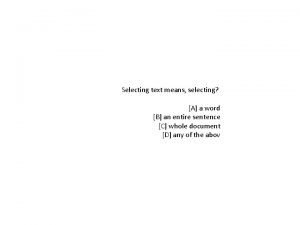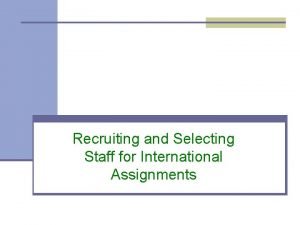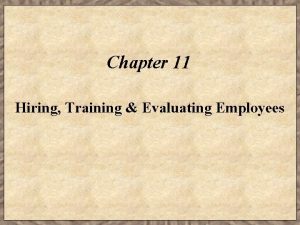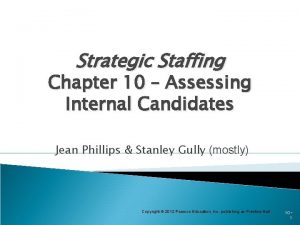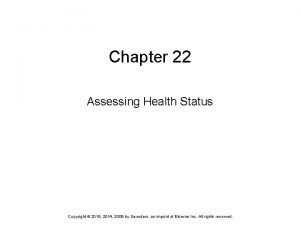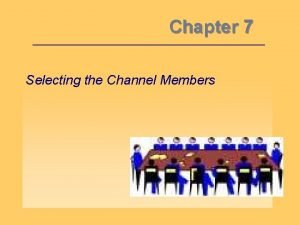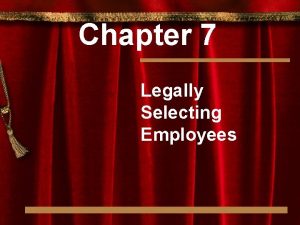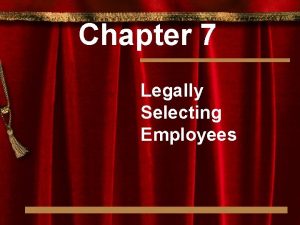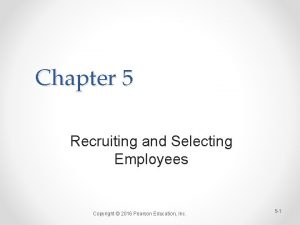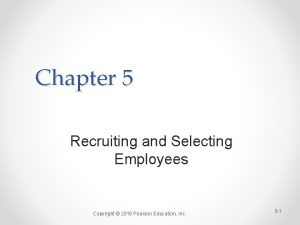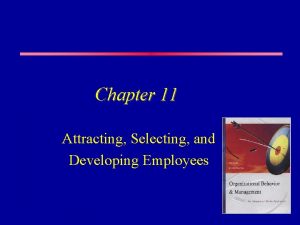CHAPTER 5 Methods for Assessing and selecting Employees












- Slides: 12

CHAPTER 5 Methods for Assessing and selecting Employees

Employee Screening and Assessment Evaluating of Written Materials ¢ Basic background information can be translated into numerical values to compare the qualifications of applicants through the use of weighted application forms or biographical information blanks (BIBs).

References and letters of recommendation ¢ ¢ ¢ Employee screening also involves references and letters of recommendation. Such sources can provide information about: l Employment and educational history. l Evaluations of the applicant’s character. l Evaluations of the applicant’s job performance. l The recommender’s willingness to rehire the applicant. The use of these methods is on the decline because they tend to be overly positive and are often uninformative.

Employment Testing ¢ ¢ The second step in screening is employee testing, which typically uses standardized instruments to measure characteristics that are predictive of job performance. Any screening test or method must demonstrate that it is a reliable and valid predictor of job performance. l A measurement instrument is reliable if it repeatedly gives the same or similar results when applied repeatedly to the same quantity. l A measurement instrument that is valid is accurately measuring what it purports to measure.

Employee Screening ¢ ¢ Three methods for establishing reliability are test‑retest reliability, parallel forms, and internal consistency. Two forms of validity that are most important for development and use of screening tests are: l Content validity, or whether the test content adequately measures the knowledge, skills and abilities required by the job. l Criterion‑related validity, or the relationship between screening test scores and some criterion of job success.

Types of Employee Screening Tests ¢ ¢ ¢ Employee screening tests vary greatly in format and in characteristics they measure. Categories of such tests include: l Cognitive ability tests. l Mechanical ability tests. l Motor and sensory ability tests. l Job skills and knowledge tests. l Personality tests. l Miscellaneous instruments such as polygraphs. Standardized tests are often used in combination in test batteries to help select the best qualified candidates.



The Effectiveness of Employee Screening Tests An important issue regarding the effectiveness of employee screening tests is validity generalization, or a test's ability to predict job performance in settings different from the one in which it was validated. ¢ Another concern is test utility, an estimate of the dollars gained in increased productivity and efficiency because of the use of screening tests. ¢

Employee Screening Faking is trying to beat an employment test by distorting responses. ¢ Assessment centers use the test battery approach to offer a detailed, structured assessment of applicants' employment potential most often for high‑level managerial positions. ¢


Hiring Interviews ¢ ¢ ¢ Employment screening for most jobs includes at least one hiring interview, which is a measurement tool just like any other screening device. Unfortunately, research indicates that hiring interviews (as they are typically used) generally have low levels of reliability and validity. One of the greatest sources of problems with hiring interviews stems from interviewer biases.
 Selecting text means
Selecting text means Screening and selecting employees international
Screening and selecting employees international The process of selecting training and evaluating employees
The process of selecting training and evaluating employees A nine box matrix requires assessing employees on ________.
A nine box matrix requires assessing employees on ________. Selecting and storing eggs
Selecting and storing eggs Chapter 5 selecting a topic and a purpose
Chapter 5 selecting a topic and a purpose Specific purpose statement
Specific purpose statement Chapter 4 cultural dynamics in assessing global markets
Chapter 4 cultural dynamics in assessing global markets Chapter 22 assessing health status
Chapter 22 assessing health status Chapter 10 motivating employees
Chapter 10 motivating employees Is the individual internal process that energizes directs
Is the individual internal process that energizes directs Chapter 7 selecting the channel members
Chapter 7 selecting the channel members Assessing grammar effectively
Assessing grammar effectively
